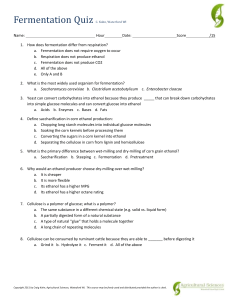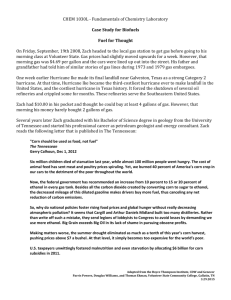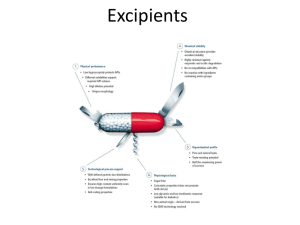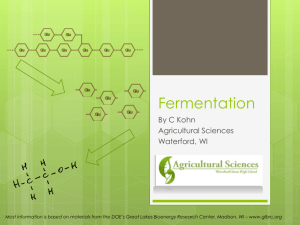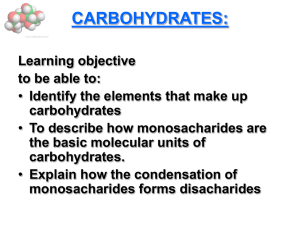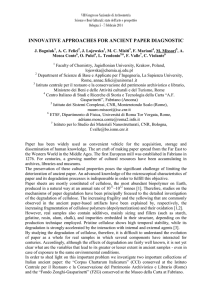Fun with Fermentation: Ethanol Production & Biofuels
advertisement
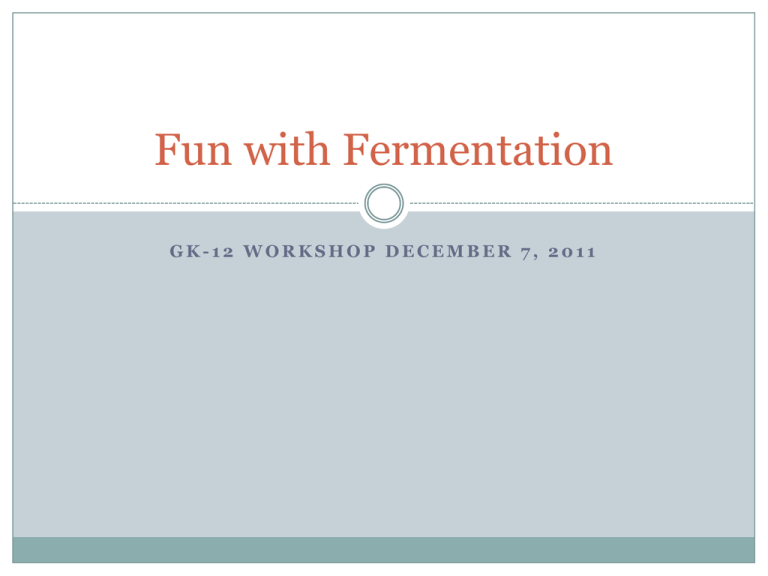
Fun with Fermentation GK-12 WORKSHOP DECEMBER 7, 2011 What is fermentation? Any of a group of chemical reactions that split complex organic compounds into relatively simple substances without oxygen. Yeast Enzymes Example: Sugar ethanol and carbon dioxide Enzyme: Any of numerous complex proteins that are produced by living cells and catalyze specific biochemical reactions (Merriam Webster) Catalyze: Cause or accelerate Ethanol Production GLBRC, 2010 Glucose Glucose is a simple sugar Carbohydrate-Carbon, Hydrogen, and Oxygen Produced by plants Glucose linked together by bonds makes starches and cellulose Starch Glucose linked together by bonds What are some examples of starch? What is the purpose of starch? Cellulose Glucose linked together by bonds Where is cellulose? What is the purpose of cellulose? Fermentation in a bag Materials Sugar Ground Corn Grass clippings Yeast 50 mL or ¼ cup of hot water Snack size Ziploc bags or balloons Fermentation in a bag Instructions Add 1 teaspoon of the feedstock, 1 teaspoon of yeast, and 50 mL of warm water to the Ziploc bag Close the bag, try to remove as much air as possible Allow the bag to set for at least 15 minutes Pre Experiment Questions Which bag contains the most CO2 after a certain period of time? Do you think the amount of CO2 production is different based on the feedstuff tested? Why do you think the amount of CO2 production will be different? Which feedstuff do you think will produce the most CO2? Which feedstuff do you think will produce the most ethanol? Why does fermentation vary among feedstuffs? Sugar=glucose Corn=starch Grass=cellulose Starch vs Cellulose https://wikispaces.psu.edu/display/Biol230WCE/Properties+of+Macromolecules+II-Nucleic+Acids,+Polysaccharides+and+Lipids Alpha 1,4 vs Beta 1,4 Alpha 1,4 bond is broken by common enzymes, such as amylase, or acid treatments Beta 1,4 bond is not easily broken, humans and animals do not have the enzyme necessary to cleave this bond Based on the results of this experiment can yeast break the alpha 1,4 or the beta 1,4 bond? Questions Which feedstuff fermented the most? How do you know? What gas accumulated in the bag and based on the reaction equation what else was produced? Why did the amount of fermentation vary among the feedstuffs? In general what do you think is the carbohydrate content is for the feedstuffs tested? How is corn used for ethanol production? Corn is starch Starch is glucose linked by alpha 1,4 bonds Yeast cannot break the alpha 1,4 bonds Enzymes or acid first break the alpha 1,4 bonds and free single glucose molecules Enzymes: amylase Why use cellulose? Cellulose makes up over half of plant biomass This makes cellulose very abundant Cellulose has potential to be the largest biofuel source Why Switchgrass? Biomass Easy to grow Marginal Lands High Temperature Drought Tolerate Perennial The trouble with cellulose… Cellulose is wrapped in lignin and hemicellulose These components have to be detangled in order to get to the cellulose This process is called pretreatment GLBRC, 2010 Pretreatment Most expensive part of the process Active research looking for enzymes or chemicals to help with the process Many bacteria and fungi can produce cellulase enzymes Or scientist will genetically modify yeast or other organisms GLBRC, 2010 New Research Before a pretreatment (cooking switch grass in hot water for 10 minutes) only 10% of cellulose was available for fermentation after pretreatment 90% of cellulose was made available for fermentation Fall switchgrass given a pretreatment and fermentation with special yeast could produce as much as 800-1,000 gallons of ethanol per acre per year, compared with 150-250 gallons per year without pretreatment. Corn ethanol from grain produces about 500-600 gallons per acre per year http://www.purdue.edu/newsroom/research/2011/110831LadischSwitchgrass.html End



